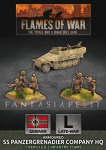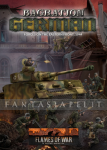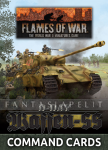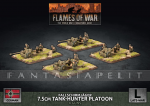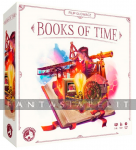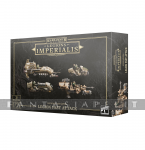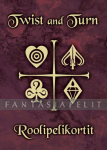The Third Reich's Last Stand
Berlin: German is a book that covers a wide variety of Formations that saw fighting in the last months of the war as the Germans attempted to hold back the Soviet juggernaut from their doorstep. They were also trying to hold back the combined onslaught of the Canadian, British, American and French forces coming from the west.
Inside you will find background on German forces on the Western and Eastern Front from January 1945 to May 1945, instructions on how to build a Panzer Battle Group, a Clausewitz Panther (IR) Tank Company, a Clausewitz StuG Assault Gun Company, a Clausewitz Panzersturm Company, a Heavy Tank Training Company, a Tank Training Company, a Berlin Fallschirmjäger Company, and a Berlin Battle Group. In addition, there is a comprehensive Painting and Basing guide, two new Missions and expanded Night Fighting rules.
Panzerdivision Clausewitz Formations: Clausewitz Panther (IR) Tank Company, Clausewitz StuG Assault Gun Company, & Clausewitz Panzersturm Company
The first formation you will find in Berlin: German is the Clausewitz Panther (IR) Tank Company. This formation represents other night fighting equipped Panther tanks that equipped several companies of both the Panzerdivision ‘Clausewitz’ and Panzerdivision ‘Müncheberg’. Clausewitz is an unusual division that was assembled from a number of orphaned, replacement, and training units from around northwest Germany. Clausewitz was made of troops from 106. Panzer-Brigade ‘Feldherrnhalle’, Panzerschule ‘Putlos’, Panzergrenadier-Regiment ‘Feldherrnhalle’, Panzergrenadier-Regiment 42, Panzer-Aufklärungs-Abteilung ‘Elbe’ and Panzerjäger-Abteilung ‘Grossdeutschland’. A number of new units were formed from various sources including Panzerartillerie-Abteilung 144 and Panzerpionier-Bataillon 144. Despite being formed as a whole division, due to shortages in motor transport Clausewitz fought as three Kampfgruppen (Battle Groups), with the armoured infantry and armour divided into two mobile groups, while the infantry and artillery, who were without motor vehicles, fought from defensive positions.
We decided to focus on two mobile groups of Clausewitz, Kampfgruppe Wallenberg and Kampfgruppe von Benningsen with the Clausewitz Panther (IR) Tank Company, Clausewitz StuG Assault Gun Company, and Clausewitz Panzersturm Company. These two battlegroups were armed with a mix of tanks. Kampfgruppe Wallenberg is based around a core of Panther tanks and StuG G assault guns with further back-up from its own platoon of Jagdpanther tank-hunters. These are further supported by panzergrenadiers, and various weapons platoons like 12cm mortars and FlaK half-tracks. Kampfgruppe von Benningsen also has a core of Panther tanks, supplemented by Panzer IV tanks, and Panzer IV/70 tank-hunters, as well as panzergrenadiers, armoured cars, anti-tank guns, and assault guns. To reflect the desperate nature of the situation we have rated these troops’ Motivation as Reluctant, but due to their experience, their Skill is rated Veteran and Hit On Careful 4+.
They can also use a new set of equipment to give them an advantage over the enemy: Infra-red night fighting equipment! By this time in the war, most Panzer schools were training new Panther tank crews to use new Infra-red scopes to locate the enemy in the dark. These were dispatched to a number of units in the field and saw action. In northwest Germany a number of British accounts recount encounters at night when British tanks came under fire from unknown enemy locations, so we decided to add the option to field Infra-red equipment. You can add this to your Panthers and Jagdpanthers, as well as equipping these platoons with an Uhu Infra-red spotlight half-track to further increase the range of vision for your Infra-red-equipped troops. In addition to the tanks, Panzersturm infantry were also issued with Infra-red equipped StG44 assault rifles and half-tracks.
If a Force with Night Fighters is the Attacker in a mission without the Meeting Engagement rule, the player may attack at night. If they do so, Night Fighting Dawn rules (page 109) are in effect at the start of the game.
If an Infra-red-equipped Formations with the Night Fighters rule is the Attacker in a mission without the Meeting Engagement rule, the player may attack at night. This negates the artillery and aircraft advantage of the Allies, allowing the Nachtjäger (or Night Hunters) to close with the enemy and take the attack to them. Berlin: German contains infra-red and other night fighting special rules.
Of course, there are other units that received night vision equipment, such as Panzerdivision Müncheberg who fought in the battles for Berlin against the Soviet Berlin Offensive.
Panzer Battle Group
Many of the Panzer Regiment of the German Armoured Forces in 1945 had a mixed bag of whatever replacement tanks or assault guns were available to replace losses. Most of the time the Formations that saw combat were Battle Groups (Kampfgruppen) rather than companies that could have everything from Panther and Panzer IV tanks to StuG assault guns and Panzer IV/70 tanks hunters, and even Tiger I tanks and attachments of Hetzer tank-hunters. At the same time, the official organisation of the Panzer Troop in 1945 led to leaner tank formation and the addition of Begleit (escort) infantry to provide the tanks with additional protection against enemy infantry.
The Panzer Battlegroup has access to some of Germany’s finest tanks and tank-hunters. You, as the commander, will be able to construct a tailor-made battlegroup to suit your tactical style and to deal with the many challenges you may face on the battlefield.
Heavy Tank Training Company and Tank Training Company
In March 1945, an emergency plan went into effect to mobilise every last panzer, self-propelled gun and vehicle in Germany’s tank training schools (such as Paderborn and Bergen) into combat units to oppose the Red Army and the Western Allies.
With the threat to Germany increasing each day, these schools organised their assets into Panzer Ausbildungs Verbände (Replacement Tank Forces). These had a very interesting variety of tanks and equipment, ranging from old Panzer II F light tanks to refurbished Tiger II tanks.
With these formations, you take on the role of a panzer instructor and lead your students into battle. You will have a wide selection of training tanks. Though old, these are still lethal fighting machines.
To represent the training school formations we have given the Headquarters Units the same ratings as regular Panzer troops (Confident 4+, Veteran 3+, Careful Hit On 4+) to represent the experienced instructors, but the Formation Units have lower ratings (Confident 4+, Green 5+, Aggressive 3+ Hit On). However, the HQ has the Old Hand special rule which allows the Formation Commander if in 6”/15cm to improve a Unit’s Tactics rating by 1 (to 4+ for the Tank Training Units).
These formations include a variety of heavy, medium, and light tanks, as well as infantry and, for the Tank Training Company, anti-aircraft half-tracks.
Berlin Fallschirmjäger Company
Hermann Göring, as the head of the Luftwaffe (Air Force), rapidly expanded the number of Fallschirmjäger divisions in 1944 and 1945. One of the last formed with 9. Fallschirmjägerdivision. This division saw extensive combat in the defence of the approaches to Berlin and inside the city itself. However, these are not the elite troops to see combat in North Africa, Italy, and Normandy. Their training was not as comprehensive as those that had gone before and only a few veterans transferred from other divisions had earned their parachute wings. Recruited mainly from excess Luftwaffe crew, they still had a high esprit de ’corps and their veteran NCOs installed a level of tenacity in them. They are rated Fearless 3+, Green 5+ but with Assault 4+, and Aggressive 3+ Hit On.
These troops are equipped as any other Fallschirmjäger. In addition, their anti-tank battalion was issued with Hetzer tank-hunters.
Berlin Battlegroup
The chaotic and ad-hoc nature of the last months of fighting in Germany and finally Berlin led to the defence being based around the auxiliary troops like the Volkssturm, RAD (National Youth Labour Organisation), and police, reinforced by small groups of well-trained watch troops and Luftwaffe anti-aircraft gunners.
Added to this were several divisions who became embroiled in the battle for Berlin only due to the fact that they had retreated into the city after the battles along the Oder River. These divisions, which included 11. SS-Panzergrenadierdivision Nordland, 9. Fallschirmjägerdivision, Panzerdivision Müncheberg, 18. Panzergrenadierdivision, and 20. Panzergrenadierdivision, were allocated to sectors of the city as they arrived in the city. There were also a number of smaller units that either made their way to the city, like the French, Spanish, and Latvian SS battalions, or arrived along with larger units like the Tiger II heavy tanks of Schwere SS-Panzer-Abteilung 503 (503rd Heavy SS Tank Battalion).
Rather than make a special briefing for each unit, we looked at how they were used during the fighting for Berlin, which was mostly in mixed battlegroups, and set about designing a single briefing that would allow you to create a force based on any of these groups. We aimed to allow the players to re-create a German force from any of the clashes inside Berlin they may have read about.
So, what does all this result in? In the Berlin Battle Group, you get one Infantry Formation, but with many options. The Berlin Battle Group has the usual structure of a Headquarter Unit, two compulsory Units and optional Units that include more infantry, machine-guns, mortars, infantry guns and anti-tank guns.
As most of the Kampfgruppen (battle groups) were led by experienced officers, the Berlin Battel Group HQ is rated Fearless 3+, Veteran 3+, Careful 4+ Hit On. The HQ also has the Old Hands special rule allowing the Formation Commander who is within 6”/15cm of a Formation Unit to let it roll Tactics on a 3+.
However, your Formation Unit can be selected from any combination of different Units with a variety of different ratings available. There are Panzergrenadier (Late) (as seen in Bulge: German) and Ardennes SS Panzergrenadier Platoons (also from Bulge: German). You can also field Fallschirmjäger Platoons (from the Berlin Fallschirmjäger Company), Hitlerjugend Platoons, Volkssturm Platoons, and Volksgrenadier Assault Platoons. You can field whole companies of any of these or any mix of them you desire.
With a number of Panzer, Panzergrenadier and independent battalions in the city there was also a wide variety of weapon options. These include Heer or SS machine-gun platoons, 8cm mortars, 7.5cm infantry gun artillery, 15cm infantry gun artillery, and 7.5cm tank-hunter platoons.
Apart from ratings, the other key difference between these platoons is they also have different equipment and upgrade options. The Panzergrenadier (Late) Platoon represents the veteran panzer and watch troops, while the Ardennes SS Panzergrenadier Platoon represent the Waffen-SS troops from the likes of the Nordland SS Division. The Panzergrenadier Platoon is made up of MG42 teams with panzerfaust anti-tank (Limited 2) with a high rate of fire and excellent anti-tank capabilities. These troops can also be armed as StG44 assault rifles, using the Limited 5 rule to allow up to five teams to fire with ROF 3/3 Range 8”/20cm for better-moving rate-of-fire, making them excellent assault troops with great close-range firepower on the move.
Hitlerjugend
Large numbers of Hitlerjugend (Hitler Youth) were organised into fighting units when it became clear that the Red Army was closing in on Germany. Many of the Hitlerjugend fought with great bravery, mostly only armed with Panzerfaust anti-tank weapons. This platoon is either made up of Panzerfaust anti-tank teams, or if they are lucky enough to get rifles as well, K98 rifle teams with Panzerfaust (Limited 2). Though because of their limited training, they don’t use the Stormtrooper special rule.
Volkssturm
The Berlin Battle Group can also take Volkssturm Platoons. The people’s militia are usually armed with old, reserve, and captured equipment. The teams of these platoons are K98 rifle teams with Panzerfaust (Limited 2) and can have one team upgraded to an MG08/15 LMG team (ROF 5/2). They have their own Local Militia rule (as does the Hitlerjugend Platoon) which means they are always deployed on the table and are never held in reserve and count as 0 points for calculating reserves. The Volkssturm also don’t use the Stormtrooper special rule.
The German Berlin Battle Group formation will allow players to create a wide variety of infantry forces with good support to recreate any of the forces they care to model from the Battle for Berlin.
Berlin: German Support
The Force Diagram allows for Support Units from SS, Fallschirmjäger, and Waffen-SS units. As well as compulsory black box Formation Support from other Formations in Berlin: German there are also support units of Tiger II heavy tanks, Jagdtiger, Elefant, Jagdpanther, Hetzer, Marder, and 8.8cm tank-hunters, Army and Luftwaffe anti-aircraft, 10.5cm, Wespe, or Hummel artillery, rocket artillery, and Army and SS armoured cars. New weapons of note include some new and unusual equipment like the Kleinpanzer Wanze (Small-tank Bedbug) and 8.8cm Waffenträger (8.8cm PaK43 Weapons Carrier).
The Bedbug (Kleinpanzer Wanze) was a conversion of the Sd Kfz 301 Borgward B IV demolition carrier rebuilt as a tank destroyer. It was armed with six Panzerschreck rocket launcher tubes in a pod on a swivel mount. The intention was that they could be used for street fighting where they could quickly move from cover to fire their rockets, before slipping into concealment to reload.
The 8.8cm Waffenträger (88mm PaK43 Weapons Carrier) was part of a German program to design light self-propelled mounts for a variety of artillery and anti-tank guns. It was loosely based on the Panzer 38(t) chassis, but wider with the engine repositioned to the front of the vehicle. Some prototypes are meant to have seen action in or around Berlin, most likely in the western suburbs. A number also saw service with the Twelfth Army’s Ulrich von Hutten Division.
The Luftwaffe troops in particular have a wide variety of anti-aircraft guns at their disposal, including the 8.8cm AA gun (FlaK37), 3.7cm AA gun (Flak43), and Quad 2cm AA gun (Flakvierling 38).
Missions
Berlin: German also included two new Missions. The first is Blood on the Streets designed to recreate the city fighting that occurred in Berlin, Vienna and many other German cities in the last months of the war. When the enemy is determined to hold a city, the attacker must ferret out each pocket of defenders, block by block, street by street until each sector is secured.
This Mission is designed to be used with city terrain with buildings, rubble and streets making up the bulk of the terrain.
Blood on the Streets featured asymmetrical forces, Obstacle rules, off-table artillery, and fortifications.
The second mission, Night Attack, recreates a German armoured night attack against a confident Allied force in a desperate attempt to hold back their advance. The enemy has been advancing continuously for days. The general has ordered you to make a counterattack to disrupt the enemy advance. You have chosen to attack under the cover of darkness to catch them by surprise and to take advantage of some new equipment that may just give you the upper hand.
This mission lets you take advantage of the night fighting capabilities of the Clausewitz Formations with Infra-red equipment featured in the book. As well as the mission, Berlin: German also includes expanded night fighting rules covering choosing a random time of day, games at Dusk, in Darkness, and at Dawn, as well as suggestions on other missions to play with the night rules.
History and extras
Scattered throughout Berlin: German is background covering the Eastern Front in 1945, the Battle for the Rhine, Operation Solstice, Panzerdivision ‘Clausewitz, Panzerdivision ‘Müncheberg’ and the Seelow Heights, Training Tank Units, 9. Fallschirmjägerdivision, the Halbe Pocket, and the Battle for Berlin.
The book includes a basing and painting guide, a terrain guide, as well as a comprehensive catalogue to aid you in collecting your Berlin: German force.
If you’re adding to an existing German force, or looking for something new, Berlin: German is sure to have something of interest.
100p A4 HC





